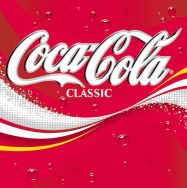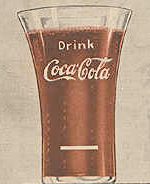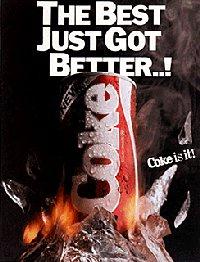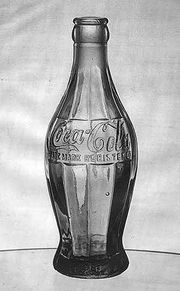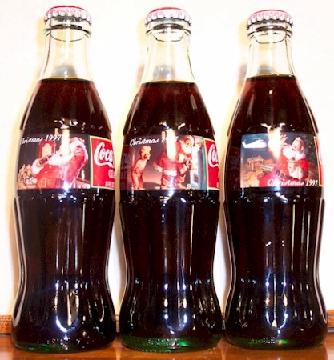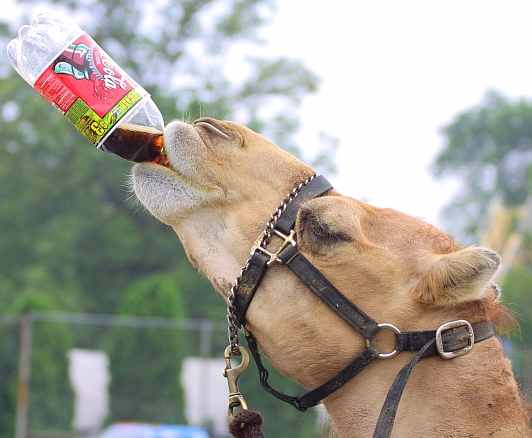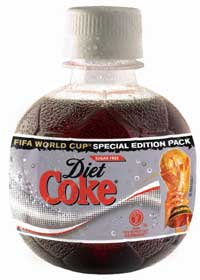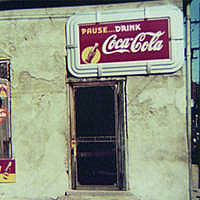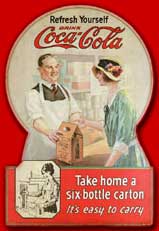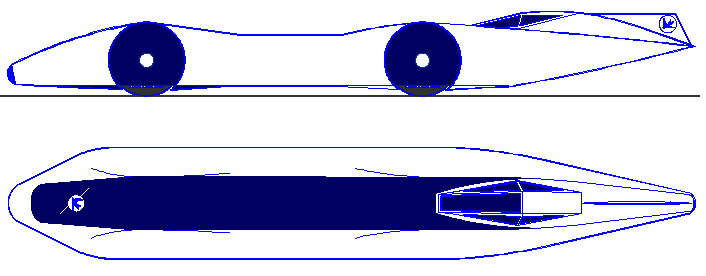|
JOHN PEMBERTON COCA COLA HISTORY
|
||||||||
|
HOME | AUTOMOTIVE | BLUEPLANET | ELECTRIC CARS | FORMULA E | ENERGY | INSURANCE | INDEX | SOLAR CARS |
||||||||
|
Coca-Cola (often abbreviated to "Coke") is a cola drink, and is the world's most popular carbonated soft drink. The Coca-Cola Company's headquarters are located in Atlanta, Georgia, where the drink was first concocted around 1884. Although Coke's inventor, John Pemberton, was not a shrewd marketer of his drink, the ownership of Coke eventually passed to Asa Candler, whose company remains the producer of Coke today. Candler's successful marketing, continued by his successors such as Robert Woodruff, established Coke as a major soft drink first in the United States and later around the world.
Originally designed to be sold at soda fountains, Coca-Cola was later sold in bottles, whose distinctive shape have become a part of the drink's branding. Major advertising campaigns have established Coca-Cola slogans such as "The pause that refreshes" as part of popular culture. The formula for Coke, whose status as a trade secret has been embellished by company lore, once contained trace amounts of cocaine, although as health regulations were tightened, this was removed a long time ago. Nevertheless, Coca-Cola has been criticized for its possible negative health effects, with many urban myths surrounding it. In addition, the commercial success of the drink has been periodically challenged, in particular by its main rival Pepsi-Cola. This tension reached its peak during the 1980s, at the height of the Cola Wars, which eventually resulted in the heavily-publicised introduction of "New Coke", intended to replace the original Coca-Cola. The widely unpopular decision was eventually rescinded in the face of public opposition.
The Coca-Cola Company has on occasion introduced soft drinks under the Coca-Cola brand name. The most famous of these is Diet Coke, which has become a major diet cola, but others exist, such as Cherry Coke. There are also some drinks marketed by the company but which remain unaffiliated with Coca-Cola the drink, such as Sprite.
History
Early years
Columbus, Georgia druggist John Stith Pemberton invented a cocawine called Pemberton's French Wine Coca in 1884, although it was originally meant to be a headache medicine. He was inspired by the formidable success of French Angelo Mariani's cocawine, Vin Mariani.
The following year, when Atlanta and Fulton County passed Prohibition legislation, Pemberton began to develop a non-alcoholic version of the French Wine Coca. He named it Coca-Cola, because it included the stimulant coca leaves from South America and was flavored using kola nuts, a source of caffeine. Pemberton called for 5 ounces of coca leaf per gallon of syrup. The first sales were made at Jacob's Pharmacy in Atlanta, Georgia, on May 8, 1886, and for the first eight months only an average of nine drinks were sold each day. Pemberton ran the first advertisement for the beverage on May 29 that year in the Atlanta Journal.
Coca-Cola was initially sold as a patent medicine for five cents a glass. Pemberton claimed Coca-Cola cured myriad diseases, including morphine addiction, dyspepsia, neurasthenia, headache, and impotence.
In 1887, Pemberton sold a stake in his company to Asa Griggs Candler, who incorporated it as the Coca Cola Corporation in 1888. In the same year, Pemberton sold the rights a second time to three more businessmen: J.C. Mayfield, A.O. Murphey, and E.H. Bloodworth. Meanwhile, Pemberton's son Charley Pemberton began selling his own version of the product. Three versions of Coca-Cola — sold by three separate businesses — were on the market.
Under Candler and Woodruff
In an attempt to clarify the situation, John Pemberton declared that the name Coca-Cola belonged to Charley, but the other two manufacturers could continue to use the formula. So, in the summer of 1888, Candler sold his beverage under the names Yum Yum and Koke. After both failed to catch on, Candler set out to establish a legal claim to Coca-Cola in late 1888, in order to force his two competitors out of the business. Candler apparently purchased exclusive rights to the formula from John Pemberton, Margaret Dozier, and Woolfolk Walker. However, in 1914, Dozier came forward to claim her signature on the bill of sale had been forged, and subsequent analysis has indicated John Pemberton's signature was most likely a forgery as well.
In 1892, Candler incorporated a second company, The Coca-Cola Company — the current corporation. In 1910, Candler had the earliest records of the company burned, further obscuring its legal origins. Regardless, Candler began aggressively marketing the product — the efficiency of this concerted advertising campaign would not be realized until much later. Candler pioneered several promotional techniques, such as the distribution of vouchers for free glasses of Coca-Cola, and advertising through media varying from soda fountain urns to wall murals (a possible ancestor of the billboard).
Coca-Cola advertisement, 1917
Coca-Cola was sold in bottles for the first time on March 12, 1894. The first bottling of Coca-Cola occurred in Vicksburg, Mississippi, at the Biedenharn Candy Company in 1891. Its proprietor was Joseph A. Biedenharn. The original bottles were six-ounce Hutchinson bottles manufactured by Biedenharn and sealed with a rubber gasket. Reportedly leaky, they were soon replaced with "crown top" bottles with straight sides, and sealed with a metal cap; variants of this design remain in use today. The distinctive "hobble-skirt" bottle design now associated with Coca-Cola was introduced in 1915.
Initially, Candler was tentative about bottling the drink, but the two entrepreneurs who proposed the idea were so persuasive that Candler signed a contract giving them control of the procedure. However, the loosely termed contract proved to be problematic for the company for decades to come. Legal matters were not helped by the decision of the bottlers to subcontract to other companies — in effect, becoming parent bottlers. This meant that Coca-Cola was originally sold in a wide variety of bottles, until the introduction of the iconic, standardized "hobble-skirt" bottle in 1916.
After the advent of bottling, the company began taking advertising even more seriously than it had before, hiring William D'Arcy, whose creations set the tone for Coca-Cola advertising that his successors would follow. D'Arcy associated Coca-Cola with typical everyday scenes of people going about their daily business; his personal view was that "Coca-Cola advertising should create scenes that drew people in and made them part of the pleasant interludes of everyday life". Instead of targeting particular population segments, D'Arcy attempted to appeal to as broad a class of people as possible, with advertising copy such as "All classes, ages and sexes drink Coca-Cola".
After Candler, the next executive to have a major impact on Coke's future was Robert Woodruff, who focused on expanding the scope of the business to the rest of the US. A noted workaholic, Woodruff would continue to have a major influence on the business long after his retirement until his death in the 1980s. Woodruff inherited leadership of the company from his father, Ernest Woodruff, who had successfully led a campaign to takeover the company from Candler in 1919. Woodruff became President of the Coca-Cola Company four years later.
Emphasising quality in the production of Coca-Cola, he initiated a "Quality Drink" campaign aimed at properly training those who served Coca-Cola at soda fountain outlets. Woodruff was also influential in establishing quality standards for the bottled version of Coca-Cola, which he thought had great potential. Looking beyond the United States, he set up a foreign department of the company in 1926, and began opening manufacturing plants in various European and Central American countries. It was Woodruff who assumed responsibility for designing Coca-Cola's foreign advertising campaigns, affixing the company logo to racing dog sleds in Canada and Spanish bullfighting arenas. He also introduced some new forms of distributing Coca-Cola, such as the six-pack carton, which made bulk purchases of Coca-Cola substantially easier.
The Coca-Cola logo is often parodied in advertisements in motion pictures This example from the animated movie Shark Tale
In 1929, the onset of the Great Depression led to fears that sales might be depressed for the year. However, an advertising campaign spearheaded with the slogan "The pause that refreshes" led per capita consumption of Coca-Cola to actually double. That same year, sales of bottled Coca-Cola overtook those of Coca-Cola sold at soda fountains for the first time. Throughout the Great Depression, Coca-Cola advertising continued to be upbeat, despite the bleak economic outlook; a 1935 advertisement depicted a man nonchalantly smiling on his way to work, presenting an idealised view of American life at the time. The proliferation of Coca-Cola, and a newcomer to the soft drink market, Pepsi, during this period led to a decline in the sales of Moxie, which had outsold Coca-Cola as recently as 1920, and continued to rival Coca-Cola's dominance of the American market. The decision of its manufacturer to cut back on advertising expenditure led to Moxie's eventual marginalization in the United States.
The Great Depression, however, also saw a setback for Coca-Cola with the arrival of a new competitor — Pepsi. With twelve ounces a bottle instead of the six ounces Coca-Cola sold, Pepsi turned the price difference to its advantage with a slick radio advertising campaign which was the first use of a jingle in advertising. "Twelve full ounces, that's a lot / Twice as much for a nickel, too / Pepsi-Cola is the drink for you," encouraged price-watching consumers to switch to Pepsi, while obliquely referring to the Coca-Cola standard of six ounces a bottle for the price of five cents (a nickel), instead of the twelve ounces Pepsi sold at the same price. Coming at a time of economic crisis, the campaign succeeded in boosting Pepsi's status as a possible challenger to Coca-Cola's dominance of the American market. From 1936 to 1938, Pepsi's profits doubled.
World War II to the 1970s
When the United States entered World War II, sugar rationing in the United States meant Coca-Cola was unable to produce drinks at full capacity. However, a deal was struck between the US government and Coca-Cola whereby the company was exempted from sugar rationing, while Coca-Cola supplied free drinks to the United States Army. The US Army permitted Coca-Cola employees to enter the front lines as "Technical Officers" where they operated Coke's system of providing refreshments for soldiers, who welcomed the beverage as a reminder of home. After the war, the soldiers brought home their newfound taste for Coca-Cola, popularising the drink. A survey of soldiers after the war indicated that veterans preferred Coca-Cola to Pepsi by an 8 to 1 ratio.
Coca-Cola has been criticised for its decision to continue trading in Nazi Germany (as did automobile manufacturer Ford, owned by vocal Anti-Semite Henry Ford) long after other US companies had relocated on moral grounds. Eventually, the difficulty of shipping Coca-Cola concentrate to Germany and its occupied states, due to the Allied blockades, led to the creation of a new drink (Fanta) by a Coca-Cola employee. Fanta is still sold worldwide to this day.
Another wartime innovation was the trademarking of "Coke" by the Coca-Cola Company, validating it as a way of referring to Coca-Cola. Although widely prevalent in vernacular usage, the company had initially fought against this practice with the reasoning that "nicknames encourage substitution". Advertising campaigns encouraged people to "ask for 'Coca-Cola' by its full name," but people persisted in asking simply for "Coke". In 1941, the company resignedly began advertising Coca-Cola jointly as Coca-Cola and Coke. In 1945, the "Coke" name was trademarked.
After World War II, Coke began expanding worldwide. Initially having been restricted only to North America and Western Europe, Coke was soon being distributed in numerous other countries, especially those, such as the Philippines, which had been occupied by the Americans during World War II. The process was aided by the company assuming control of a number of Coca-Cola manufacturing plants which had been established during the war by the army, with help from the company, in order to spur distribution of the drink to soldiers.
New Coke stirred up a controversy when it replaced the original Coca-Cola in 1985. The original formula was reinstated as Coca-Cola Classic within a few months
New Coke to the present
In 1985, Coca-Cola, amid much publicity, changed the formula of the drink (although the "formula" had been "changed" a few years before by the substitution of 1/2 of the original 100% cane sugar sweetener with cheaper corn syrup which never provoked any public outcry). Some authorities believe that New Coke, as the reformulated drink came to be known, was invented specifically to respond to its commercial competitor, Pepsi. Numerous blind taste tests suggested that more consumers preferred the taste of Pepsi (which is believed to have more lemon oil, less orange oil, and uses vanillin rather than vanilla) to Coke. In taste tests, drinkers were more likely to respond positively to sweeter drinks, and Pepsi had the advantage over Coke because it is much sweeter. Coca-Cola tinkered with the formula and created the new Coke. Follow-up taste tests revealed that most consumers preferred the taste of New Coke to both Coke and Pepsi. The reformulation was led by the then CEO of the company, Roberto Goizueta, and the president Don Keough.
It is unclear what part long-time company president Robert W. Woodruff played in the reformulation. Goizueta claims that Woodruff endorsed it a few months before his death in 1985; others have pointed out that, as the two men were alone when the matter was discussed, Goizueta might have misinterpreted the wishes of the dying Woodruff, who could speak only in monosyllables. It has also been alleged that Woodruff might not have been able to understand what Goizueta was telling him.
The New Coke therefore came as a grievous blow to the management of The Coca-Cola Company. It is possible that customers would not have noticed the change if it had been made secretly or gradually, and thus brand loyalty could have been maintained. Coca-Cola management was unprepared, however, for the nostalgic sentiments the drink aroused in the American public; some compared changing the Coke formula to rewriting the American Constitution.
The new Coca-Cola formula subsequently caused a public backlash. Consumers began buying up and hoarding supplies of Old Coke, before it disappeared forever. Gay Mullins, from Seattle, Washington, founded the Old Cola Drinkers of America organization, which attempted to sue the company, and lobbied for the formula of Old Coke to be released into the public domain. This and other protests caused the company to return to the old formula under the name Coca-Cola Classic on July 10, 1985. However Coca-Cola Classic is not the true old formula, as it introduced high fructose corn syrup as a substitute to sugar. The company was later accused of performing this volte-face as an elaborate ruse to introduce a new product while reviving interest in the original. Donald Keough, company president at the time, responded to the accusation by declaring: "Some critics will say Coca-Cola made a marketing mistake. Some cynics will say that we planned the whole thing. The truth is we are not that dumb, and we are not that smart."
Meanwhile, the market share for New Coke had dwindled to only 3% by 1986. In 1992 the company renamed the product "Coke II" (not to be confused with "Coke C2", a reduced-sugar cola launched by Coca-Cola in 2004). However, sales falloff caused a severe cutback in distribution. By 1998, it was sold in only a few places in the Midwestern United States.
Internationally, sales of Coke vary from country to country, although it is the dominant soft drink in virtually every country it is sold. Due to its symbolic association with the United States, Coca-Cola has been a target of anti-Americanism in the Middle East. One such instance in 2000 saw an erroneous claim that the Coca-Cola label contained anti-Islamic phrases in Arabic when viewed in a certain way. The Coca-Cola Company claimed sales dropped 10 to 15% in Egypt after the rumour began spreading in 2000, even though the Grand Mufti of Egypt declared that the trademarked script logo "does not injure Islam or Muslims". United States foreign policy also served as a focal point for boycotts of Coca-Cola due to its perceived associations with America. Alternatives to Coca-Cola, such as Mecca Cola, began proliferating in Europe and the Middle East, ostensibly as a way to combat "America's imperialism and Zionism by providing a substitute for American goods and increasing the blockade of countries boycotting American goods". The Coca-Cola Company stated that sales had felt "some impact" as a result of the boycotts and launch of alternative colas, but declined to elaborate.
Nevertheless as of 2006, Coca-Cola is the best-selling soft drink in most countries. However, Pepsi is often second to Coke in terms of sales, and outsells Coca-Cola in some localities. Few other soft drinks have posed a challenge to Coke's domination of the global market, although some local brands such as Mecca Cola have made gains against Coke in recent years. In Peru, Inca Kola outsells Coca-Cola, although Corporación Inca Kola del Perú S.A., the company that formerly produced Inca Kola, was purchased by the Coca-Cola Company in 1999. In Sweden, despite Coca-Cola's strong holiday-oriented marketing efforts, Julmust outsells Coca-Cola during the Christmas season, while in Scotland, the locally produced Irn-Bru was more popular until 2005 when Coca-Cola and Diet Coke began to outpace its sales.
First version of the famous bottle went into production in 1916
Attempts To Steal Secret Formula
A Coca-Cola employee and two other people were arrested on July 6, 2006 and charged with trying to sell "highly classified" information to the soft drink maker's competitor, PepsiCo for $1.5 million. The recipe for Coca-Cola Classic, perhaps the company's most closely guarded secret, was never in jeopardy. Instead, the information was related to a new beverage in development. Coca-Cola executives verified that the documents were valid and proprietary. At least one glass vial containing a sample of a new drink was offered for sale, court documents said. The conspiracy was revealed by PepsiCo, which notified the authorities when they were approached by the conspirators.
Production
Coca-Cola formula
As a publicity marketing strategy started by Ernest Woodruff, the company presents the formula of Coca-Cola as one of the most closely held trade secrets in modern business that only a few employees know or have access to. In particular, the secret ingredient "7X" has long been touted an integral component of Coca Cola's formula though it has never been established what, if anything, the "X" refers to. It has been stated that Coca-Cola had employees mix the drink by numbers assigned to specific ingredients rather than by name, to avoid the possibility of employees reverse-engineering the recipe. However, experienced perfumers and food scientists — today aided by modern analytical methods — can easily identify the composition of food products, a fact that is further supported by the many cola flavorings and competing soft drinks like Pepsi.
Franchised production model
The actual production and distribution of Coca-Cola follows a franchising model. The Coca-Cola Company only produces a syrup concentrate, which it sells to various bottlers throughout the world who hold Coca-Cola franchises for one or more geographical areas. The bottlers produce the final drink by mixing the syrup with filtered water and sugar (or artificial sweeteners) and fill it into cans and bottles, which the bottlers then sell and distribute to retail stores, vending machines, restaurants and food service distributors. The bottlers are normally also responsible for all advertisement and other sales initiatives within their areas.
The Coca-Cola Company owns minority shares in some of its largest franchisees, like Coca-Cola Enterprises, Coca-Cola Hellenic Bottling Company (CCHBC) and Coca-Cola FEMSA, but fully independent bottlers produce almost half of the volume sold in the world.
As the bottler adds sugar and sweeteners, the sweetness of the drink is said to differ in various parts of the world, in order to cater for local taste.
Bottle and logo design
The famous Coca-Cola logotype is said to have largely been created by John Pemberton's business partner, Frank Mason Robinson, in 1885. It was Robinson who came up with the name, and he also chose the logo’s distinctive cursive script. The typeface used, known as Spencerian script, was developed in the mid 19th century and was the dominant form of formal handwriting in the United States during that period.
The equally famous Coca-Cola bottle, called the "Contour bottle" within the company, but known to some as the "hobble skirt" bottle, was created in 1915 by a Swedish former glassblower, Alexander Samuelson, who had emigrated to the US in the 1880's and was employed as a manager at The Root Glass Company in Terre Haute, Indiana, one of Coca-Cola's bottle suppliers. According to the Coca-Cola Company, Samuelson took time to ponder a possible new design for the bottle after production at his plant was shut down due to a heat wave. Inspired, he considered the possibility of basing a new design on the kola nut or coca leaf, two of the drink's flagship ingredients. He sent an employee to research the shape of the two objects in question, but a misunderstanding led to the man returning with sketches of the cacao pod — a crucial ingredient in chocolate, but not Coca-Cola. According to the company, it was this mistaken design that was accepted and put into production.
Although endorsed by the company, this version of events is not considered authoritative by many who cite its implausibility as difficult to believe. One alternative depiction has Raymond Loewy as the inventor of the unique design, but although Loewy did serve as a designer of Coke cans and bottles in later years, he was in the French Army in the year the bottle was invented and did not migrate to the United States until 1919. Others have attributed inspiration for the design not to the cacao pod, but to a Victorian hooped dress.
Specially designed Christmas labels featuring Santa Claus give a seasonal twist to these Coca-Cola bottles
Advertising
Coca-Cola's advertising has had a significant impact on American culture, and is frequently credited with the "invention" of the modern image of Santa Claus as an old man in red-and-white garments; however, while the company did in fact start promoting this image in the 1930s in its winter advertising campaigns, it was already common before that. In the 1970s, a song from a Coca-Cola commercial called "I'd Like to Teach the World to Sing", produced by Billy Davis, became a popular hit single, but there is no evidence that it did anything to increase sales of the soft drink. Coke's advertising has been rather pervasive, as one of Woodruff's stated goals was to ensure that everyone on Earth drank Coca-Cola as their preferred beverage. Advertising for Coke is now almost ubiquitous, especially in southern areas of North America, such as Atlanta, where Coke was invented.
Coca-Cola has gone through a number of different advertising slogans in its long history, including "The pause that refreshes", "I'd like to buy the world a Coke", "The Real Thing" and "Coke is it".
As a result of extensive campaigns in the early 20th century, the Coca-Cola drink has a high degree of identification with the United States itself, being considered an "American brand" or to a small extent as representing America (compare Mickey Mouse). By 1948, it was reported that when non-Americans thought of democracy — a trait associated with the United States — they thought of Coca-Cola.
Starting in 1975, Pepsi-Cola ran a series of television advertisements showing people participating in taste tests in which they expressed a preference for Pepsi over Coke. Coca-Cola ran ads to combat Pepsi's ads in an incident sometimes referred to as the cola wars; one of Coke's ads compared the so-called Pepsi challenge to two chimpanzees deciding which tennis ball was furrier.
The Coca-Cola has a long history of sports marketing relationships, which over the years have included several major sports leagues both in the United States and internationally. Two such notable instances are Coca-Cola's sponsorship of the Olympic games, with Coke being the first-ever sponsor of an Olympic game at the 1928 Summer Olympics in Amsterdam, and also Coca-Cola's sponsorship of FIFA, which organises football tournaments such as the FIFA World Cup.
Urban legends and unusual uses
The numerous urban legends about Coca-Cola have led the Urban Legends Reference Pages to devote a whole section of their site to "Cokelore". Coca-Cola has in particular been the target of urban legends decrying the drink for its supposedly copious amounts of acid (its pH value of 2.5 is midway between vinegar and gastric acid), or the "life-threatening" effects of its carbonated water. These urban legends usually take the form of "fun facts" — for example, "highway troopers use Coke to clean blood from highways after accidents," "somebody once died in a Coke-drinking competition," or "Coke can dissolve a tooth overnight." All of these claims are false. (While highway troopers do not use Coca-Cola for this purpose, the television program MythBusters showed that Coca-Cola could be used as a blood cleaning agent.) Claims of Coca-Cola's unique tooth dissolving properties have been debunked as urban legend. Coca-Cola was also once believed to have been a possible form of birth control due to this allegedly high acidity level being able to supposedly 'kill sperm'.
Camel drinks a Coke
One unusual use for Coke is as a rust-control substance—the phosphoric acid in Coke converts iron oxide to iron phosphate, and as such can be used as an initial treatment for corroded iron and steel objects being renovated, etc. The acid can be used to anodize titanium according to various websites. Corroded battery terminals on cars are often corrected through the use of Coca-Cola.
According to popular belief, the coca leaf extract cocaine was once added to Coca-Cola, per se. Because cocaine is naturally present in untreated coca leaves, small amounts of cocaine were also present in the beverage. Today's Coca-Cola uses "spent" coca leaves, those that have been through a cocaine extraction process, to flavor the beverage. Since this process cannot extract the cocaine alkaloids at a molecular level, the drink still contains trace amounts of the stimulant. The United States DEA oversees the importation of coca for Coca-Cola, and later sale of the extracted cocaine to the drug industry where it is used in the creation of many of the common drugs whose names end in "-caine" (such as Procaine and Lidocaine).
Criticism of Coca-Cola
The Coca-Cola Company has been criticised for the allegedly adverse health effects of its flagship product. However, a common criticism of Coke based on its allegedly toxic acidity levels has been found to be baseless by most researchers; lawsuits based on these criticisms have been dismissed by several American courts for this reason.
Most nutritionists advise that Coca-Cola and other soft drinks can be harmful if consumed excessively, particularly to young children whose soft drink consumption competes with, rather than complements, a balanced diet. Studies have shown that regular soft drink users have a lower intake of calcium (which can contribute to osteoporosis), magnesium, ascorbic acid, riboflavin, and vitamin A. The drink has also aroused criticism for its use of caffeine, an addictive substance.
Although numerous court cases have been filed against The Coca-Cola Company since the 1920s, alleging that the acidity of the drink is dangerous, no evidence corroborating this claim has been found. In some of these cases, evidence has been presented that claimed Coca-Cola is no more harmful than comparable soft drinks or acidic fruit juices like apple juice. Under normal conditions, scientific evidence indicates Coca-Cola's acidity causes no immediate harm.
Like most other colas, Coca-Cola contains phosphoric acid. One study has shown that this hastens bone loss, contributing to illnesses such as osteoporosis.
There is also some concern regarding the usage of high fructose corn syrup in the production of Coca-Cola. Since the late-1980s in the U.S., Coke has been made with high fructose corn syrup, instead of sugar glucose or fructose, to reduce costs. This has come under criticism because of concerns that the corn used to produce corn syrup may come from genetically altered plants. Some nutritionists also caution against consumption of high fructose corn syrup because of possible links to obesity and diabetes.
In India, there exists a major controversy concerning pesticides and other harmful chemicals in bottled products including Coca-Cola. In 2003, the Centre for Science and Environment (CSE), a non-governmental organisation in New Delhi, said aerated waters produced by soft drinks manufacturers in India, including multinational giants Pepsico and Coca-Cola, contained toxins including lindane, DDT, malathion and chlorpyrifos — pesticides that can contribute to cancer and a breakdown of the immune system. Tested products included Coke, Pepsi, and several other soft drinks, many produced by The Coca-Cola Company. CSE found that the Indian produced Pepsi's soft drink products had 36 times the level of pesticide residues permitted under European Union regulations; Coca Cola's 30 times. CSE said it had tested the same products in the US and found no such residues. After the pesticide allegations were made in 2003, Coca-Cola sales declined by 15%. In 2004, an Indian parliamentary committee backed up CSE's findings, and a government-appointed committee was tasked with developing the world's first pesticide standards for soft drinks. The Coca-Cola Company has responded that its plants filter water to remove potential contaminants and that its products are tested for pesticides and must meet minimum health standards before they are distributed.
The Coca-Cola Company has also been accused of human rights violations including; use of paramilitaries in Colombia, mistreatment of unionised employees and taking the groundwater required by farmers in India. The Coca-Cola Company disputes these claims.
football (soccer ball) shaped Diet Coke Bottle was launched as part of a promotion campaign for the FIFA World Cup 2006
In May, 1886, Coca Cola was invented by Doctor John Pemberton a pharmacist from Atlanta, Georgia. John Pemberton concocted the Coca Cola formula in a three legged brass kettle in his backyard. The name was a suggestion given by John Pemberton's bookkeeper Frank Robinson.
Being a bookkeeper, Frank Robinson also had excellent penmanship. It was he who first scripted "Coca Cola" into the flowing letters which has become the famous logo of today. The soft drink was first sold to the public at the soda fountain in Jacob's Pharmacy in Atlanta on May 8, 1886.
About nine servings of the soft drink were sold each day. Sales for that first year added up to a total of about $50. The funny thing was that it cost John Pemberton over $70 in expanses, so the first year of sales were a loss.
Until 1905, the soft drink, marketed as a tonic, contained extracts of cocaine as well as the caffeine-rich kola nut.
By the late 1890s, Coca-Cola was one of America's most popular fountain drinks. With another Atlanta pharmacist, Asa Griggs Candler, at the helm, the Coca-Cola Company increased syrup sales by over 4000% between 1890 and 1900.
Advertising, was an important factor in Pemberton and Candler's success and by the turn of the century, the drink was sold across the United States and Canada. Around the same time, the company began selling syrup to independent bottling companies licensed to sell the drink. Even today, the US soft drink industry is organized on this principle.
Until the 1960s, both small town and big city dwellers enjoyed carbonated beverages at the local soda fountain or ice cream saloon. Often housed in the drug store, the soda fountain counter served as a meeting place for people of all ages. Often combined with lunch counters, the soda fountain declined in popularity as commercial ice cream, bottled soft drinks, and fast food restaurants came to the fore.
On April 23, 1985, the trade secret "New Coke" formula was released. Today, products of the Coca Cola Company are consumed at the rate of more than one billion drinks per day.
A trade secret is any information that allows you to make money because it is not generally known. A trade secret could be a formula, computer program, process, method, device, technique, pricing information, customer lists or other non-public information. If the economic value of a piece of information relies on it being kept private, it could be a trade secret.
One of the most famous examples of a trade secret is the formula for Coca-Cola. The formula, also referred to by the code name "Merchandise 7X," is known to only a few people within the company and kept in the vault of a bank in Atlanta, Georgia. The individuals who know the secret formula have signed non-disclosure agreements, and it is rumored that they are not allowed to travel together. In the past, you could not buy Coca-Cola in India because Indian law required that trade-secret information be disclosed. In 1991, India changed its laws regarding trademarks, and Coca-Cola can now be sold in that country.
Trade secrets are very different from patents, copyrights and trademarks. While patents and copyrights require you to disclose your information in the application process (information that eventually becomes public), trade secrets require you to actively keep the information secret. Trade-secret protection can potentially last longer than that of patents (20 years) and copyrights (100 years). Some of the ways to protect a trade secret are as follows:
Trade secrets remain valid only as long as no one else has discovered the information independently, the information has not been made public (by employees or published literature) nor discovered by working backward from the original product/process or publicly observing the product/process. If the trade secret is revealed in violation of a non-disclosure agreement, you can sue for damages. However, once the secret is revealed, it is hard to get the trade-secret status resumed. Trade secrets are protected under many state laws, Federal statutes and some international laws.
Further Development of the Drink
The Coca-Cola company started out as an insignificant one man business and over the last one hundred and ten years it has grown into one of the largest companies in the world. The first operator of the company was Dr. John Pemberton and the current operator is Roberto Goizueta. Without societies help, Coca-Cola could not have become over a 50 billion dollar business. Coca-Cola was invented by Dr. John Pemberton, an Atlanta pharmacist. He concocted the formula in a three legged brass kettle in his backyard on May 8, 1886. He mixed a combination of lime, cinnamon, coca leaves, and the seeds of a Brazilian shrub to make the fabulous beverage (Things go better with Coke 14). Coca-Cola debuted in Atlanta's largest pharmacy, Jacob's Pharmacy, as a five cent non- carbonated beverage.
Later on, the carbonated water was added to the syrup to make the beverage that we know today as Coca-Cola. Coca-Cola was originally used as a nerve and brain tonic and a medical elixir. Coca-Cola was named by Frank Robinson, one of Pemberton's close friends, he also penned the famous Coca-Cola logo in unique script. Dr. John Pemberton sold a portion of the Coca-Cola company to Asa Candler, after Pemberton's death the remainder was sold to Candler. Pemberton was forced to sell because he was in a state of poor health and was in debt. He had paid $76.96 for advertising, but he only made $50.00 in profits. Candler acquired the whole company for $2,300 (Coca-Cola multiple pages).
Candler achieved a lot during his time as owner of the company. On January 31, 1893, the famous Coca-Cola formula was patented. He also opened the first syrup manufacturing plant in 1884. His great achievement was large scale bottling of Coca-Cola in 1899. In 1915, The Root Glass Company made the contour bottle for the Coca-Cola company.
Candler aggressively advertised Coca-Cola in newspapers and on billboards. In the newspapers, he would give away coupons for a free Coke at any fountain. Coca-Cola was sold after the Prohibition Era to Ernest Woodruff for 25 million dollars. He gave Coca-Cola to his son, Robert Woodruff, who would be president for six decades (Facts, Figures, and Features Multiple pages). Robert Woodruff was an influential man in Atlanta because of his contributions to area colleges, universities, businesses and organizations. When he made a contribution, he would never leave his name, this is how he became to be known as "Mr. Anonymous."
Woodruff introduced the six bottle carton in 1923. He also made Coca-Cola available through vending machine in 1929, that same year, the Coca- Cola bell glass was made available. He started advertising on the radio in the 1930s and on the television in 1950. Currently Coca-Cola is advertised on over five hundred TV channels around the world. In 1931, he introduced the Coke Santa as a Christmas promotion and it caught on. Candler also introduced the twelve ounce Coke can in 1960. The Coca-Cola contour bottle was patented in 1977. The two liter bottle was introduced in 1978, the same year the company also introduced plastic bottles (Coca-Cola multiple pages).
Woodruff did have one dubious distinction, he raised the syrup prices for distributors. But he improved efficiency at every step of the manufacturing process. Woodruff also increased productivity by improving the sales department, emphasizing quality control, and beginning large-scale advertising and promotional campaigns. Woodruff made Coke available in every state of the Union through the soda fountain. For all of these achievements he earned the name, "The Boss" (Facts, Figures, and Features Multiple pages). In 1985, the Coca-Cola Company made what has been known as one of the biggest marketing blunder. The Coca-Cola company stumbled onto the new formula in efforts to produce diet Coke. They put forth 4 million dollars of research to come up with the new formula.
The decision to change their formula and pull the old Coke off the market came about because taste tests showed a distinct preference for the new formula. The new formula was a sweeter variation with less tang, it was also slightly smoother (Demott 54). Robert Woodruff's death was a large contributor to the change because he stated that he would never change Coca-Cola's formula. Another factor that influenced the change was that Coke's market share fell 2.5 percent in four years. Each percentage point lost or gain meant 200 million dollars. A financial analyst said, "Coke's market share fell from 24.3 percent in 1980 to 21.8 percent in 1984" (Things go better with Coke 14).
This was the first flavor change since the existence of the Coca- Cola company. The change was announced April 23, 1985 at the Vivian Beaumont Theater at the Lincoln Center. Some two hundred TV and newspaper reporters attended this very glitzy announcement. It included a question and answer session, a history of Coca-Cola, and many other elements (Oliver 131).
The debut was accompanied by an advertising campaign that revived the Coca-Cola theme song of the early 1970s, "I'd Like to Buy the World a Coke" (Say it ain't so, Coke 24). The Jingle read like this: I'd like to teach the world to sing In perfect harmony. I'd like to buy the world a Coke And keep it company. The change to the world's best selling soft drink was heard by 81 percent of the United States population within twenty-four hours of the announcement. Within a week of the change, one thousand calls a day were flooding the company's eight hundred number (1-800-GET-COKE). Most of the callers were shocked and/or outraged, many said that they were considering switching to Pepsi. Within six weeks, the eight hundred number was being jammed by six thousand calls a day. The company also fielded over forty thousand letters, which were all answered and each person got a coupon for the new Coke. A retired Air Force officer, explained in a letter to the Coca-Cola company that he wanted to be cremated and interred in a Coke can, but now that this change had come about he was reconsidering (Pendergrast Multiple pages).
Sharlotte Donneally, a thirty-six year old anthropologist said, "I hate the new stuff" (Demott 60). Wendy Koskela, a thirty-five year old vice president of an insurance company said, "It's too sweet. It tastes like Pepsi." She also stated, "Real Coke had punch. This taste almost like it's flat" (Demott 60). Many American consumers of Coca-Cola asked if they would have the final say. When Pepsi heard that the Coca-Cola company was changing its secret formula they said that it was a decision that Pepsi tastes better. Roger Enrico, the president and CEO of Pepsi-Cola wrote a letter to every major newspaper in the U.S. to declare the victory, the letter read like this (Oliver 128): It gives me great pleasure to offer each of you my heartiest congratulations. After eighty-seven years of going at it eyeball to eyeball, the other guy just blinked. Coca-Cola is withdrawing their product from the marketplace, and is reformulating brand Coke to be more like Pepsi...There is no question the long-term market success of Pepsi has forced this move...Maybe they finally realized what most of us have known for years, Pepsi tastes better than Coke. Well, people in trouble tend to do desperate things...and we'll have to keep our eye on them. But for now, I say, victory is sweet, and we have earned a celebration. We're going to declare a holiday on Friday. Enjoy! Best Regards, Roger Enrico President, CEO Pepsi-Cola USA Coca-Cola officials said, "The new formula will boost Coke's share by 1 percent. That is worth 200 million dollars a year."
Coca-Cola management had to decide: Do nothing or "buy the world a new Coke" (Things go better with Coke 14). They decided to develop the new formula. Roberto Goizueta, the president of the Coca-Cola Company stated, "The old Coke formula, with its secret flavoring ingredient, called Merchandise 7X, will stay locked in the Trust Company of Georgia bank vault in Atlanta, never to be used again" (Demott et. al 55). This is what many Coke officials said, "This is the most significant soft drink development in the company's history" (Demott et. al 54). The change back to the old Coke was known as the Second Coming. Roberto Goizueta said, "Today, we have two messages to deliver to the American consumer, first, to those of you who are drinking Coca-Cola with its great new taste, our thanks...But there is a second group of consumers to whom we want to speak to today and our message to this group is simple: We have heard you" (Oliver 178). On July 10, 1985, eighty-seven days after the new Coke was introduced, the old Coke was brought back in addition to the new one. This was greatly due to dropping market share and consumer protest. The market share fell from a high of 15 percent to a low of 1.4 percent (Miller 38). Roberto Goizueta and Donald Keough took full blame for this failed product launch. Don Keough, Coca-Cola president, said in response to the comeback, "The truth is we are not dumb and we are not that smart" (New bottle 18). Roberto Goizueta's response when the change about, "We have heard you" (Moore 8). This was said to be a classic marketing retreat.
Coca-Cola executives admitted that they had goofed by taking the old Coke off the market. One old Coke loyalist said, "The company had spoiled the taste of its ninety nine year old soft drink and betrayed a national trust" (Moore 8). Ike Herbert, a Coke marketer said, "You would have thought we had invented a cure for cancer" (Pendergrast 366). The Coca- Cola company's eight hundred number received eighteen thousand calls of gratitude. One caller said they felt like a lost friend had returned home. The comeback of old Coke drove stock prices to the highest level in twelve years. This was said to be the only way to regain the lead on the cola wars (Classic comeback of an old champ 12). In 1979, fifteen hundred employees moved to the new corporate headquarters in Atlanta located on North Avenue. The new corporate headquarters came to be known as "The Tower."
During the time when the research for the new formula was taking place, it was known as "The Bunker" (Oliver 53). The known ingredients in present day Coca-Cola are water. caffeine, phosphoric acid, vanilla, various oils and essences and extracts of the coca leaf and the kola nut. The one in four hundred part of cocaine was removed from Coca-Cola in 1903(Demott 54). Five years after the infamous Coke fiasco, the Coca-Cola company tried to bring back the reformulated Coke.
The effort to phase in Coke II into the soda market was quite unsuccessful (Miller 38). During the Woodruff era, Mr. Woodruff made a promise to the armed forces of the United States to supply Coca-Cola to every serviceperson. He said that costs and location did not matter, he supplied 5 billion bottles to the service. In the mid-1970's, more than half Coca-Cola sold was outside of the U.S. Coca-Cola products outsell closest competitor by more than two to one. One in every two colas and one in every three soft drinks is a Coca-Cola product (Facts, Figures, and Features 16). The best known trademark in the world is sold in about one hundred and forty countries to 5.8 billion people in eighty different languages. This is why Coca-Cola is the largest soft drink company in the world. Coca-Cola is worth more than 58 billion dollars on the stock market (Coca-Cola, The Coca-Cola Company 232). For more than 65 years, Coca-Cola has been a sponsor of the Olympics.
The 1996 Summer Olympics will be held in Atlanta, Georgia, the home of Coca-Cola. One great earmark that the Coca-Cola company has is helping the people of Atlanta. They accomplish this through scholarships, hotlines, donations and contributions, etc. Another large accomplishment that the Coca-Cola has, is being the first company to make and use recycled plastic bottles. One way to see all of the achievements of the Coca- Cola company is to visit the World of Coke in Atlanta. It houses a collection of memorabilia, samples of the products, exhibits, and many other exciting items (Facts, Figures, and Features Multiple pages). All of what has been said is the basis of what Coca-Cola was built on. Without societies help, Coca-Cola could not have become over a 50 billion dollar business. Keep on consuming the world's favorite soft drink, Coca-Cola.
In 2005 Coca Cola were invited to introduce a new brand cola to celebrate the launch of .........................
BOOK DESCRIPTION
Coca-Cola has become such a ubiquitous American symbol such that it's often hard to distinguish where mere substance ends (its formula is a secret as closely held as military stealth technology) and its seductively overwhelming marketing begins. But in the 1980s and '90s, Coke's new corporate management evolved it from a reliable, if sometimes stodgy, icon of American industry into one of the hottest stocks in a notoriously overheated bull market. That explosive corporate evolution is the focus of veteran NY Times beverage industry reporter Constance Hays' cautionary business history.
Eschewing strict chronology in favor of skillfully weaving in appropriate pieces of the company's complex legacy and unique coporate culture to underscore their impact on the contemporary story at hand, Hays carefully dissects a company billed in boom years as a virtual perpetual profit machine of boundless potential. Coke's growth was largely the product of Roberto Goizueta, the methodical, Cuban-born chemist who'd risen through the company's ranks and outflanked fellow veteran executive/personable "super salesman" Don Keough to become its CEO. Goizueta may have been able to rise above the hubris-fueled "New Coke" reformulation fiasco of the mid-80s, but his penchant for ruthless market expansion, corporate rejiggering and tight control of the company's operating details and financial numbers would also sow the seeds for the inevitable collapse that halved Coke's value. That implosion quickly took down successor CEO Doug Forrester--ironically the original financial architect of much of the company's remarkable boom.
While this is largely a business history and not a cultural one, it's filled with a wealth of telling human details: corporate pressures exerted on family-owned Coke bottlers to sell out; an obscure academic/stock analyst whose curiosity helped unravel the company's financial secrets; Machiavellian corporate politics where one era's loser becomes another's cautious victor. - Jerry McCulley
LINKS and REFERENCE
The
Coca-Cola Company.
History
of Coca Cola and its Evolution - A long and detailed history of Coca
Cola. Dr.
John Pemberton - Inventor of
Coca-Cola History
of Pop - Timeline of the entire history of soft drinks.
ON
THE BOOKSHELF:
Solar Cola drinkers make better drivers ......
Solar Cola Earth can - The World in Your Hands
Please note: For the avoidance of doubt, unless otherwise stated, there is no connection between our hosts or products/projects mentioned on this website.
We aim to provide balanced unbiased reporting on sailing events, global warming and renewable energy usage in the modern world. If you have a story you would like us to cover, please use the contact given at the foot of this page. We are not responsible for the content of third party websites. Happy surfing dudes.
Please click on the links above to find out about these famous automotive makers. If your company is not included and you would like to be listed, please let us know.
The world's fastest electric car: 350mph + using energy from nature. Featuring built in battery cartridge exchange, charged using renewable solar energy. Sponsors sought for the 2016 season.
|
||||||||
|
BLUEPLANET BE3 ELECTRIC | EDUCATION | ELECTRIC CYCLES | SOLARNAVIGATOR |
||||||||
|
The
content of this website is copyright © 1991 and 2013 Electrick
Publications. All rights reserved. The bluebird logo |
||||||||
